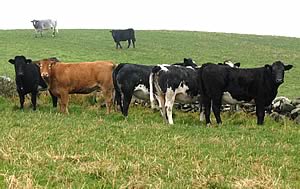| 2009-12-07
Once-bred heifers could be an excellent way for suckler herds to boost output without increasing cow numbers in response to the continuing imbalance between quality beef calf demand and domestic supply, according to the latest Beef Action for Profit sheet from EBLEX, the industry body for beef and lamb levy-payers in England.
Breeding from heifer calves before finishing them for slaughter offers the opportunity to boost the number of finishing stock annually produced from suckler herds by more than 25%. It is unlikely to adversely affect the eating quality or value of finished heifers. And with good management it should not add significantly to labour or organisational demands either.
From the 90 live calves produced each year by a typical 100 cow herd – 45 of which are heifers – EBLEX estimates 40 will be suitable for breeding. Allowing for 20 herd replacements, this leaves 20 available for once-bred heifer production, resulting in 18 more calves per year than would otherwise have been the case (Table).
Table: The Potential Impact of Once-Bred Heifers on Annual Suckler Herd Stock Output
100 Breeding Cows |
Standard Regime |
Once-Bred Heifer Regime |
| Bull calves for finishing |
45 |
45 |
| Heifer calves for replacements |
20 |
20 |
| Heifer calves for finishing |
25 |
5 |
| Once-bred heifers for finishing |
- |
20 |
| Calves from once-bred heifer for finishing |
- |
18 |
| Total stock for finishing |
70 |
88 (+26%) |
To achieve the most from once-bred heifer beef, EBLEX recommends:
- Selecting well grown heifer calves at 6-8 month weaning;
- Maintaining growth rates of 0-7-0.8 kg/day through to calving without over-fatness;
- Breeding at 15 months and 65% of their mature weight for calving at 24 months;
- Breeding to bulls with EBVs for low birth weight and above average calving ease;
- Matching the breeding period to the main herd to ensure foster cows availability;
- Calving down at Body Condition Score 3.0;
- Supervising calvings to ensure any problems are dealt with fast and effectively;
- Removing calves after 2-3 days of colostrum intake for foster cow double suckling;
- Drying-off bred heifers on a maintenance diet for up to 10 days; and,
- Finishing bred heifers rapidly 6-8 weeks after calving;
Central to success is ensuring all heifers are at the correct weight at bulling and gain weight steadily during pregnancy without becoming over-fat.
While udder development and uterine weight may reduce killing out percentage by 2-3%, this should be more than compensated for by additional body weight.
 EBLEX Launches Ewe Nutrition Manual EBLEX Launches Ewe Nutrition Manual
 UK Studies Confirm Forage Chicory Potential UK Studies Confirm Forage Chicory Potential
 Out-Wintering Options Help Farmers Reduce Costs Out-Wintering Options Help Farmers Reduce Costs
|


